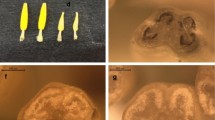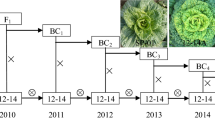Summary
Ten cytoplasmic male sterile (CMS) sunflower (Helianthus annuus L.) lines were crossed with nine maintainer or male fertility restorer lines in a diallel crossing scheme. Based on fertility restoration of the F1 generation, CMS lines were divided into four groups. At least two new sources of CMS, CMS PET2 and CMS GIG1, were found to be potentially useful for commercial production of hybrids. Environment had an influence on fertility restoration of one CMS line, CMS MAX1. Effective restoration of male fertility for CMS RIG1, CMS ANN2, and CMS ANN3 was not found.
Similar content being viewed by others
References
AnaschenkoA.V., T.V.Mileeva & V.T.Rozhkova, 1974. Sources of male sterility in sunflower. Genetike i Selektsii 53–3: 242–254.
ChristovM., 1990. A new source of cytoplasmic male sterility in sunflower originating from Helianthus argophyllus. Helia 13: 55–61.
EnnsH., D.G.Dorrell, J.A.Hoes & W.O.Chubb, 1970. Sunflower Research, a progress report. In: Proc. 4th Int. Sunflower Conf. 23–25 June 1970, Memphis, TN, USA. Int. Sunflower Assoc., Toowoomba, Qld., Australia. p. 162–167.
HookerA.L., D.R.Smith, S.M.Lim & J.B.Beckett, 1970. Reaction of corn seedlings with male-sterile cytoplasm to Helminthosporium maydis. Plant Dis. Rep. 54: 708–712.
JanC.C. & J.N.Rutger, 1988. Mitomycin C- and streptomycin-induced male sterility in cultivated sunflower. Crop Sci. 28: 792–795.
KinmanM.L., 1970. New developments in the USDA and state experiment station sunflower breeding programs. In: Proc. 4th Int. Sunflower Conf. 23–25 June 1970, Memphis, TN, USA. Int. Sunflower Assoc., Toowoomba, Qld., Australia. p. 181–183.
LeclercqP., 1969. Une stérilité mâle cytoplasmique chez le tournesol. Ann. Amélior. Plant. 19: 99–106.
LeclercqP., 1971. La stérilité mâle cytoplasmique du tournesol. I. Premières études sur la restoration de la fertilité. Ann. Amélior. Plant. 21: 45–54.
LeclercqP., 1983. Etude de divers cas de stérilité mâle cytoplasmique chez le tournesol. Agronomie 3 (2): 185–187.
Miller, J.F. & S.L. Wolf, 1991. Registration of three cytoplasmic male-sterile and three restorer sunflower germplasm lines. Crop Sci. 31: in press.
SchneiterA.A. & J.F.Miller, 1981. Description of sunflower growth stages. Crop Sci. 21: 901–903.
Serieys, H., 1987. Study and utilization in breeding programs of new CMS sources. FAO Research Network on Sunflower Report. p. 1–13.
VranceanuV.A. & F.M.Stoenescu, 1971. Pollen fertility restorer gene from cultivated sunflower (Helianthus annuus L.). Euphytica 20: 536–541.
WhelanE.D.P. & W.Dedio, 1980. Registration of sunflower germplasm composite crosses CMG-1, CMG-2 and CMG-3. Crop Sci. 20: 832.
WolfS.L. & J.F.Miller, 1985. Fertility restoration response of various sunflower cytoplasms. In: Proc. 11th Int. Sunflower Conf. 10–13 March 1985, Mar del Plata, Argentina. Int. Sunflower Assoc., Toowoomba, Qld., Australia. p. 549–552.
Author information
Authors and Affiliations
Rights and permissions
About this article
Cite this article
Havekes, F.W.J., Miller, J.F. & Jan, C.C. Diversity among sources of cytoplasmic male sterility in sunflower (Helianthus annuus L.). Euphytica 55, 125–129 (1991). https://doi.org/10.1007/BF00025224
Received:
Accepted:
Issue Date:
DOI: https://doi.org/10.1007/BF00025224




